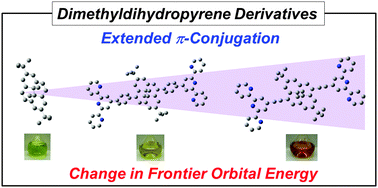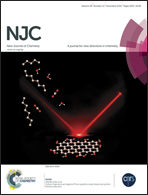π-Conjugation modification of photochromic and redox-active dimethyldihydropyrene by phenyl- and ethynyl-terpyridines and Ru(bis-terpyridine) complexes†
Abstract
Two π-conjugated dimethyldihydropyrene (DHP)-bis-terpyridine ligands (2 and 3) were prepared, in which two terpyridine moieties were connected at the 4 and 9 positions of DHP (1) via phenyl and ethynyl linkers, respectively. The nature of the π-conjugated linkers influenced the valence orbitals of the DHP moiety, which shifted the redox potentials of the DHP moiety and the absorption spectra. In 3 with an ethynyl linker, the redox potentials of the DHP moiety were shifted in the positive direction and the absorption band was largely red-shifted compared with 1. In 2 with a phenyl linker, the shifts in the redox potentials of the DHP moiety and in the absorption band were moderate. These results were supported by valence orbital energies calculated using time-dependent density functional theory, which enabled the assignment of the four main transitions in each spectrum for the first time. The fluorescence intensity of 3 was larger than that of 2, which was photoisomerisable. Two dinuclear Ru(bis-terpyridine) complexes (4 and 5) were prepared from 2 and 3, and their redox and photochemical properties were investigated.


 Please wait while we load your content...
Please wait while we load your content...